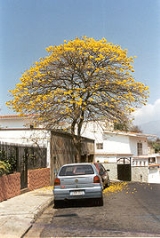
Tabebuia chrysantha
Encyclopedia

Brazil
Brazil , officially the Federative Republic of Brazil , is the largest country in South America. It is the world's fifth largest country, both by geographical area and by population with over 192 million people...
, is a native tree of the intertropical broadleaf deciduous forests of South America
South America
South America is a continent situated in the Western Hemisphere, mostly in the Southern Hemisphere, with a relatively small portion in the Northern Hemisphere. The continent is also considered a subcontinent of the Americas. It is bordered on the west by the Pacific Ocean and on the north and east...
above the Tropic of Capricorn
Tropic of Capricorn
The Tropic of Capricorn, or Southern tropic, marks the most southerly latitude on the Earth at which the Sun can be directly overhead. This event occurs at the December solstice, when the southern hemisphere is tilted towards the Sun to its maximum extent.Tropic of Capricorn is one of the five...
. On May 29, 1948, Tabebuia chrysantha was declared National Tree of Venezuela
Venezuela
Venezuela , officially called the Bolivarian Republic of Venezuela , is a tropical country on the northern coast of South America. It borders Colombia to the west, Guyana to the east, and Brazil to the south...
since being an emblematic native species of extraordinary beauty. Its deep yellow resembles the one on the Venezuelan flag
Flag of Venezuela
The current flag of Venezuela was introduced in 2006.The basic design includes a horizontal tricolor of yellow, blue, and red, dating to the original flag introduced in 1811, in the Venezuelan War of Independence....
. It is one of about 100 species of Tabebuia
Tabebuia
Tabebuia is a neotropical genus of about 100 species in the tribe Tecomeae of the family Bignoniaceae. The species range from northern Mexico and southern Florida south to northern Argentina, including the Caribbean islands of Hispaniola and Cuba...
.
Designation
Chrysantha is derived from two Greek words and means "golden flower". Araguaney appears to derive from "aravenei", the ancient word by which Caribes designated this tree.Habitat
The araguaney dwells in clearings of deciduous tropical forests of the broad Guiana Shield region. It is also native to warm lands and sabanas (Vía Oriente to El GuapoEl Guapo
El Guapo can refer to:* El Guapo , a comic book character and a member of the superhero team X-Statix.* El Guapo, Miranda State, a town located at Miranda State, Venezuela....
, Cupira
Cúpira
Cúpira is a city in the state of Miranda, Venezuela. It is the capital of Pedro Gual Municipality....
, and Uchire Sabana) and even some arid hills (Mampote, Guarenas
Guarenas
Guarenas is a city in Miranda, Venezuela. It was established in 1621 as Nuestra Señora de Copacabana de los Guarenas. On February 27, 1989, a morning protest in this city over the recent nationwide hike in bus fares, spread to Caracas, the capital of Venezuela, which resulted in several days of...
, Guatire
Guatire
Guatire is a city in Miranda, Venezuela. In 2006, its population has been estimated at 200,417. Today, Guatire has virtually merged with its neighbor, Guarenas....
y Caucagua
Caucagua
Caucagua is a Venezuelan city in the state of Miranda, and is capital of the Acevedo Municipality.The town of later Caucagua was called as Valle de Araguata about 1690, It was refounded with the name of Caucagua in 1752. Bishop Mariano Martí gave it the name Nuestra Señora del Valle de la Santa...
). Its habitat ranges 400 to 1300m above sea level.
Description
It is a rustic decidious tree that defies hard, dry or poor soils. Therefore its roots require well drained terrain. Its height ranges 6 to 12m. Leaves are opposite and petiolate, elliptic and lanceolate, with pinnate venation. Flowers are large, tubular shaped, with broadening corolla of deep yellow colour, about 2 inches long; they come out (February to April) before the tree has grown back any leaves. The fruit consists of dehiscent capsuleCapsule (fruit)
In botany a capsule is a type of simple, dry fruit produced by many species of flowering plants. A capsule is a structure composed of two or more carpels that in most cases is dehiscent, i.e. at maturity, it splits apart to release the seeds within. A few capsules are indehiscent, for example...
often matured by the end of dry season. It is a slow growing, but long lasting, tree.
As said, flowering and fruiting take place in dry season, from February to April, this way the seeds can take advantage of early rains. If raining season is delayed, the araguaney may flower and fruit, mildly, a second time. It is a highly efficient moisture manager. As happens with mango
Mangifera indica
Mangifera indica is a species of mango in the Anacardiaceae family. It is found in the wild in India and cultivated varieties have been introduced to other warm regions of the world...
, the araguaney biological functions requiring most water take place precisely during dry season.
Trivia
By the 1970s Ford Motor Company of Venezuela published a notorious cultural magazine named Aravenei (a name for araguaney). Its editor was famous twentieth century Venezuelan poet and writer Juan LiscanoJuan Liscano
Juan Liscano Velutini Venezuelan poet, folklorist, writer and critic. Director of Monte Ávila Editores, amongst his poetic work emphasizes: Nuevo mundo Orinoco , Cármenes and Fundaciones...
. It dealt with varied articles of geographic, historical, and cultural relevance.

